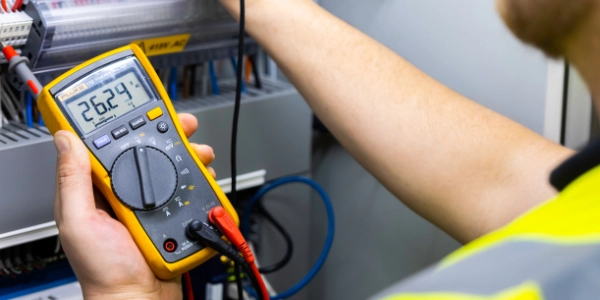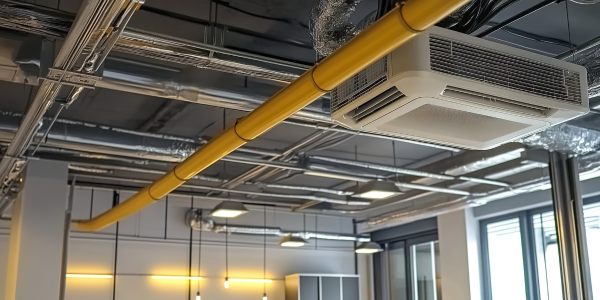what are building automation systems?
‘Building Automation Systems’ (BAS), ‘Building Management Systems’ (BMS) and more recently ‘smart buildings’, are all alternative types of control systems that integrate different types of building systems into a centralised and managed network infrastructure.
These building systems use sensors and devices to monitor and regulate:
- Heating, ventilation and air conditioning (HVAC)
- Lighting
- Security and access
- Fire alarms and safety systems
- Energy Management Systems (EMS)
- Electrical & water management
Building automation system vs building management system vs smart buildings
Smart buildings take building efficiency to the next level by interconnecting a building’s sensors, IoT sensors and devices so that they can work in unison, sharing data to manage the building’s ecosystem in real time.
BAS provides basic automation and control capabilities, while BMS offers more comprehensive monitoring and analytics capabilities. BAS can be adjusted to allow for the size and complexity of the building, while BMS is suited for larger premises.
Why are building automation systems essential?
Effectively managing medium-to large-sized buildings poses significant challenges:
- rising utility expenses
- temperature inconsistencies that create discomfort
- lighting levels that are frequently misaligned with the workspace requirements
- ventilation that varies by work zone and impacts staff productivity levels
- air quality and particulate monitoring
Further complications arise when overseeing multiple buildings.
A viable solution to address the majority of these issues is the integration of a building automation system. When properly executed, a building automation system can result in enhanced energy efficiency, reduced operational and maintenance costs, improved indoor air quality, increased occupant comfort and, therefore, heightened productivity.
How do they work?
Building automation typically consists of five main components:
- Sensors that oversee and monitor each component within the system, encompassing temperature, lighting, security, and other elements. Should any sensor identify a problem, it will transmit an alert to the system controls.
- Controllers that monitor the data provided by the sensors. Using this information, the controllers issue instructions to various system components. For example, they can notify the heating or cooling system to adjust the temperature based on sensor-detected issues.
- Output control devices that execute commands from the system controls, implementing adjustments in the building systems. Examples include turning off or dimming lights in zones that aren’t currently in use, or adjusting the heating and cooling outputs of the building’s HVAC to maintain the required temperature(s).
- Unique language that is understood by all the components and used to send commands within the system. These are often referred to as protocols. Two of the most common protocols employed by BAS and BMS are BACnet and Modbus.
- User interfaces that allow building owners and managers to observe the present status of all building systems. Manual adjustments to the current system settings are also permitted, if required.

What are the opportunities with building automation systems?
Increased energy efficiency
When employed effectively, building automation systems typically result in a rapid return on investment. Automation systems optimise energy consumption, leading to potentially significant cost savings. According to a study carried out by the U.S. General Services Administration, buildings with automation systems can achieve energy savings of up to 30%.
Enhanced occupant comfort and productivity
Building automation ensures a comfortable environment for occupants by maintaining optimal temperature, lighting and air quality. One of the most notable BAS benefits is temperature control. By increasing temperatures before occupants arrive and turning them down after everyone leaves, building automation eases cold morning temperatures in the winter and oppressive temperatures during the summer. Numerous health studies over the years have proven the link between comfortable work environments and employee productivity, as well as well-being.
Better connectivity and monitoring of systems
Building owners and managers can remotely monitor and control various systems via building automation systems, providing flexibility and the ability to address issues promptly. Automation streamlines building operations by automating routine tasks, reducing manual intervention and providing centralised control. This leads to more efficient and effective building management.
Predictive maintenance
Automation systems can monitor equipment performance and predict potential issues, allowing for proactive maintenance to prevent costly breakdowns and downtime. This helps to reduce unexpected equipment breakdown and emergency repair costs.
What are the challenges with building automation systems?
Cyber security poses the biggest threat
While building automation dictates that all devices and equipment are connected to your network, this potentially opens the door to hackers. Not all building automations may be secure and can feature vulnerabilities. It is vital that measures are taken to improve the security of building automation by:
- ensuring each user has unique login details
- confirming passwords are unique and complex
- installing a fully functioning firewall
- closing off any unused ports
Future-proofing automation systems against obsolescence
Building owners and managers looking to invest in the energy efficiency of their properties should seek building automations that can respond to the changes in technology, as well as their occupants’ evolving needs.
For the most part, a software update is sufficient. In terms of future-proofing your BAS, developing a comprehensive plan outlining budget considerations, operational requirements and future expansion strategies is a crucial first step.
When your building automation system reaches the end of its lifecycle, it is advisable to upgrade the software and network, with existing hardware being replaced as the forecasted budget and schedule allow.
Building automation is at the heart of efficient and intelligent building management
Careful planning, including budget considerations and future scalability, is crucial for success. As technology evolves, regular updates ensure sustained relevance. To fully unlock the potential of building automation, engaging a qualified building control systems expert is imperative. This transformative technology establishes the groundwork for sustainable, future-ready structures, reshaping the way we approach building management.
Get in touch
Cube Controls is an established and experienced supplier of Building Management Systems, specialising in the design and set up of bespoke environmental and energy control programmes for commercial buildings and property.
To find out how Cube Controls can support you at all stages of design and consultancy, installation and modification and maintenance of your building management systems contact our expert and friendly team on 01903 694279 or sales@cubecontrols.co.uk.





